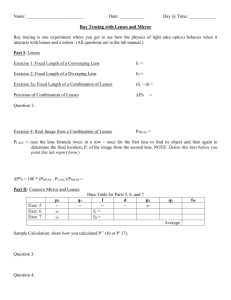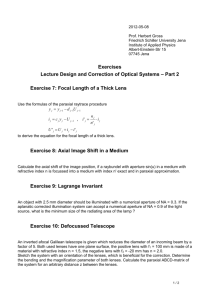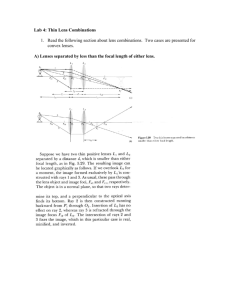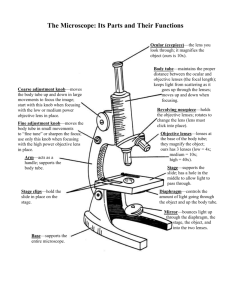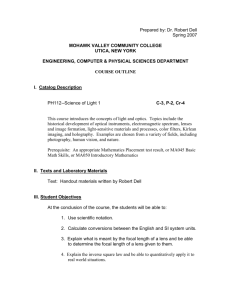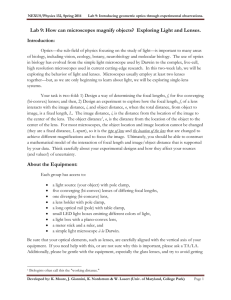History of refractive x
advertisement
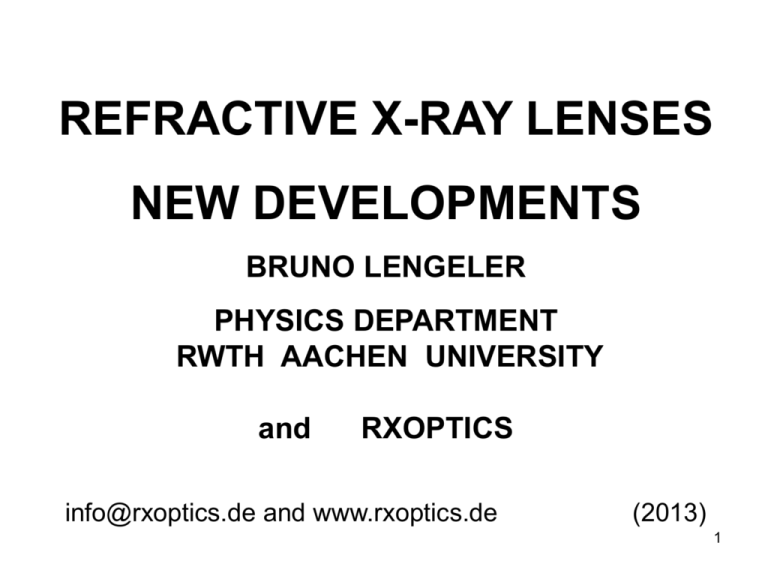
REFRACTIVE X-RAY LENSES NEW DEVELOPMENTS BRUNO LENGELER PHYSICS DEPARTMENT RWTH AACHEN UNIVERSITY and RXOPTICS info@rxoptics.de and www.rxoptics.de (2013) 1 A. History of refractive x-ray lenses > have been considered as not feasible for a long time > visible light: index of refraction n = 1 + d with d ~ 0.5 for glass * refraction strong * absorption weak * focal length short * focusing lens convex > x-rays: n = 1 – d + ib * refraction weak * absorption strong * focal length long * focusing lens concave 1m with d, b ~ 10-6 and positive ~ 100m „There are no refractive lenses for x-rays!“ W.C.Roentgen BUT: refraction is not zero and absorption is not infinite! 2 Rotational parabolic and linear parabolic x-ray lenses from RXOPTICS Be / AL parabolic lenses (Aachen) linear Al lens A =1 x 3.5 mm2 R = 200 mm 10 mm 2D Be lenses 1.5 mm 1 mm 500 mm 300 mm 200 mm 50 mm 3 Linear Be lenses (cylinder paraboloids) length 2.5mm R=500µm R=1500µm 4 DEVELOPMENT OF REFRACTIVE X-RAY LENSES 1. W.C.Roentgen (1896) found no refraction of x-rays by matter, concluded that there are no refractive lenses for x-rays, this statement is still found in most textbooks of optics. 2. P.Kirkpatrick, A.V.Baez (1948) on search for x-ray optics: realized the importance of low refraction and of strong absorption that hamper the fabrication of refractive x-ray lenses mentioned the possibility to stack lenses in order to reduce the focal length, gave up the idea of refractive lenses in favor of crossed mirrors which carry their names (K-B mirrors). 5 3. R.Gähler, J.Kalus, W.Mampe (1980) Test of a refractive neutron lens developed for the search of a neutron charge: 2 biconcave cylinder lenses stacked behind one another with circular profile (radius 2.4mm), made of quartz, resulting in a focal length of 2.5m for cold neutrons of 20 A wavelength. The possibility to transfer the concept to x-rays is not mentioned. N.B.: materials for neutron lenses should have a large coherent cross-section and small incoherent and absorption crosssections. 6 4. S.Suehiro, H.Miyaji, H.Hayashi (1991) considered one spherical biconcave lens of high Z material (Au, Pt, W) no follow-up of idea 5. B.X.Yang (1993) considered one parabolic lens of low Z material saw problems in manufacturing this lens proposed Fresnel lenses instead of refractive lenses 6. T.Tomie (1994-1997) proposed row of drilled holes in a straight line => stacking of individual lenses reduces focal length alignment problem is solved patent: Japan 1994 USA, Germany 1995 USA 1997 presented at XRM conference Wuerzburg (August 1996) 7 BUT: * idea was not tested by author * linear lens with strong spherical aberration * rough cylinder surfaces * it is difficult to control the form fidelity: drilling of a hole deforms the adjacent hole 8 The stacking of individual lenses is explicitely excluded in the patent as not feasible! Patent: X-ray lens T. Tomie U.S. Patent 1997 # 5,684,852 … (3) The total focal distance fT can be reduced to f/N by cascading N X-ray lenses of long focal distance f, as shown in Fig. 1. In this configuration, however, many unit X-ray lenses have to be arranged after fabricating the individual unit X-ray lenses. The thickness of each unit X-ray lens has to be very thin to avoid strong absorption of X-rays, making each unit X-ray lens very fragile and difficult to handle. Moreover, aligning the optical axes of all unit X-ray lenses along the X-ray lens axis with high precision would be extremely difficult. Hence, arranging many X-ray lenses in the configuration shown in Fig. 1 is practically impossible. … 9 7. A. Snigirev, I. Snigireva, V. Kohn, B. Lengeler (1996) Nature 384, 49 (1996) received 19 June 1996, accepted 19 September 1996. first realisation and test of refracting x-ray lens (linear row of drilled holes in Al and later in Be) => showed feasibility of these lenses => not suitable as an optical device beryllium lenses with holes 0.5 mm in diameter 10 Substantial improvement in design and manufacturing made at Aachen University and at RXOPTICS * parabolic form is a must! * biconcave form is a must! * stacking of many individual lenses in a row with µm precision was achieved * low Z material * in the mean time more than 4000 lenses (rotationally parabolic and cylinder parabolic) made in Be, Al and Ni have been delivered to 15 institutions in 10 countries. * 1996-2010: more than 600 publications on and with refractive x-ray lenses * at ESRF: about 50% of beamlines equiped with refractive x-ray lenses. * others took over the concept: SPring8, ANKA, Kurchatov. 11 B. Strategy for design of refractive x-ray lenses 1 2 (1 n) lensmaker formula: f R d 2.70(l rZ / A)10 2 6 or R f 2d l in Angstrom r in g/cm³ Z atomic number A atomic mass in g To obtain a small focal length: small radius of curvature R: down to 50µm high density of lens material 12 Requirements on refractive x-ray lenses i). Lens surfaces must be parabolic single 2D-lens parameters for Be lenses: R = 50 to 1500µm and up to 5.8mm 2R0 = 0.45 to 2.5mm d below 30µm parabolic profile: no spherical aberration focusing in full plane => excellent imaging optics 13 Comparison parabolic versus spherical lens parabolic spherical 25µm spherical lenses are inappropriate for imaging! 14 ii). stacking many lenses in a row f R / 2dN (thin lens) variable number of lenses : N = 1 to about 300 Precision of stacking: better than 1µm typical: f = 0.2m - 10m 15 iii). Thick lenses * if L << f (thin lens): f0 = R / 2dN * if L comparable to f : rays are bent towards optical axis inside lens r(z) R 0 cos z 2d RF refracting power/length F: thickness of lens platelet 16 Focal length of thick lens f f0 L f0 sin L f 0 L length of lens stack (N*2z0) f0= R / 2dN thin lens approximation 17

